Final report for GNE18-191
Project Information
Although growing strawberries under plastic low tunnels can extend the growing season, such plastics may also provide a favorable environment for some pests. This study compared pest presence on open field vs. low tunnel strawberry and evaluated effective biological control options for spider mites (Tetranychus urticae Koch) and tarnished plant bugs (Lygus lineolaris Palisot de Beauvois). Our study suggests that low tunnels provide an optimal environment for growing strawberries, and while they reduce infestation by some pests (namely plant pathogens and Drosophila suzukii Matsumura), they exacerbate the presence of others (namely Tetranychus urticae). Lastly, our study suggests UV-blocking plastics can be used to optimize Beauveria bassiana efficacy and improve biocontrol of tarnished plant bug on low tunnel strawberry. Overall, low tunnels provide an optimal growing environment for strawberries and can be manipulated to improve efficacy of some biopesticides. However, weighing these benefits against likely outbreaks of some pests is important for growers to consider when implementing this system in the Northeast.
1. Describe the incidence of strawberry pests under low tunnels with a focus on arthropods, pathogens, and weeds. Pest surveys will be conducted on low tunnel strawberry at research and commercial sites. We predict that several pests of strawberry will respond positively under plastic tunnels such that they reach higher densities on low tunnel strawberry. There is currently little research devoted to pest surveys of protected culture crops although this production system is increasing in popularity among growers in the Northeast. By comparing pest presence eon open field vs. low tunnel strawberry, this objective will develop new information on pest barriers and challenges of low tunnel systems.
2. Develop biological control recommendations for two-spotted spider mite low tunnel strawberry. A major concern of strawberry growers is the effect low tunnels have on spider mites, as this species is pesticide resistant and reproduces well under plastic tunnels. A promising alternative for control of spider mites is biological control. Objective 2 is intended to develop tunnel-specific recommendations for spider mite management using biocontrol tactics. Several commercially available predatory mite species will be compared for spider mite control in greenhouse and field experiments.
3. Optimize control of tarnished plant bug (Lygus lineolaris) using the entomopathogen, Beauveria bassiana on low tunnel strawberry. To date, control of tarnished plant bug by this fungus has been unsuccessful on field grown strawberry. Factors limiting its success include exposure to low relative humidity and harmful ultraviolet radiation in the open field, both of which reduce spore germination and pathogenicity of Beauveria bassiana. A major goal of this objective is to determine if plastic low tunnels provide a better environment for applying B. bassiana, by reducing exposure to UV and maintaining higher a higher humidity, to increase the success of this entomopathogen against tarnished plant bug on strawberry.
Results generated from the above objectives will be presented at grower meetings, published in peer-reviewed journals and extension bulletins, and will be developed into instructional YouTube videos to broadly disseminate research findings.
Many growers in the Northeast are interested in low tunnel systems to maximize strawberry yields. However, tunnel systems are relatively new to the region and information on pest management is lacking. The purpose of this project is to identify the dominant pests of low tunnel strawberries and to develop tunnel-specific cultural and biological control recommendations for the two-spotted spider mite (Tetranychus urticae) (TSSM) and tarnished plant bug (Lygus lineolaris) (TPB) which are often problematic under low tunnels.
TSSM is a serious pest of strawberry worldwide and is becoming increasingly resistant to chemical control. In addition, this pest appears to reach especially high densities on protected culture strawberry compared to those grown in the open field. This is likely due the warm, dry and hospitable environment created by the low tunnels. In addition, growers are reporting severe damage by TPB on low tunnel strawberry, but it is unknown if damage is greater than strawberry grown in the open field. This bug is highly polyphagous, and can move into crops from nearby weeds. It is particularly devastating on strawberry because it deforms developing fruit during feeding, rendering fruit as "cattfaced" and unmarketable if present. The effect of low tunnels on the presence of other pests, including pathogens, weeds and herbivorous arthropods on strawberry is unknown.
Management if TSSM and TPB is often difficult, and highly reliant on pesticides. Biocontrol organisms (predatory mites and entomopathogenic fungi against TSSM and TPB, respectively) are commercially available to growers in the Northeast. However, control of TSSM by predatory mites is highly variable and unpredictable, and has not been fully evaluated on low tunnel strawberry in the Northeast. Applying entomopathogenic fungi (namely Beauveria bassiana) against TPB has largely been unsuccessful on field strawberry, but also has not been evaluated under low tunnels where conditions are likely to be more favorable.
Information on pest barriers and recommendations for management is needed by low tunnel strawberry growers. This project aims to address this by identifying common weeds, pathogens and arthropod pests that are likely to be targets of control under low tunnels, and by developing specific recommendations for management of TSSM and TPB. Results generated from this study is intended to provide a foundation on which to build IPM programs and to promote sustainable agriculture.
Research
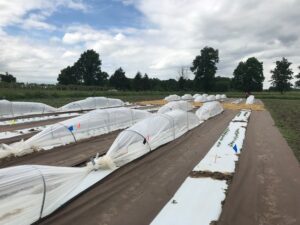
Objective 1: A day neutral strawberry planting (var. ‘Albion’) was established that included both low tunnel production and open production in the field during 2018 and 2019 (Fig. 1). Arthropod pests, pathogens, and weeds were monitored throughout the season with a specific emphasis placed on species commonly found on strawberry. A combination of pitfall traps, sticky cards, vacuuming were conducted to describe general arthropod pest abundance while targeted sampling was conducted to monitor for specific strawberry pests. This included baited slug traps, flower tapping (for tarnished plant bug monitoring), and incubating ripe fruit to determine infestation rates of spotted-wing drosophila or other fruit pests. Weeds were harvested every two weeks to determine relative weed abundance between open-field and low tunnel grown strawberries, and visual surveys in both systems were conducted to describe pathogen incidence on fruit and foliage. This effort was extended in 2019 to monitor for pest at two grower sites, and one additional research site across central NY.
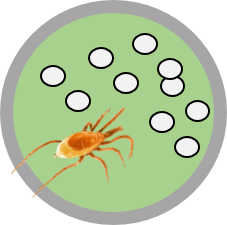
Objective 2: Predator efficacy was evaluated for two predatory mite species (Phytoseiulus persimilis and Neoseiulus fallacis) against TSSM on low tunnel strawberry in lab, greenhouse and field experiments. Predators were reared on bean plants infested with spider mite prey in lab before use in experiments. In lab experiments, prey consumption was monitored over 48 hours by inoculating a strawberry leaf disc, containing 10 TSSM eggs, with an adult female predator (Fig. 2). The number of consumed eggs was counted every 24 hours for 3 days. The same field planting used in Figure 1 was also utilized to compare efficacy of P. persimilis, N. fallacis and a combination of both predators against a no-predator control on low tunnel strawberry.
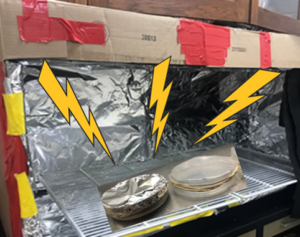
Objective 3: Experiments were conducted in the lab to determine if plastics mitigate exposure of B. bassiana to UV and how this may impact biocontrol against TPB. First, agar plates inoculated with conidia of two strains of B. bassiana (GHA and ANT-03) at a concentration of 1 X 106 conidia mL−1 and covered with either one of three plastic treatments (Warps Flex-O-Glass, Tufflite IV, and Dubois) ranging in UV transmission from low to high or a control (saran wrap or aluminum foil to serve as positive and negative controls, respectively). Plates were then exposed to a UV-B dose 40.3 kJ m−2 in an UV chamber (Fig. 3) and incubated for 16 hours to determine percent spore germination. This experiment was repeated again on live TPB adults. After UV exposure, bugs were placed in growth chambers and monitored every two days to determine time of death. Once dead, cadavers were moved onto moist paper towels to monitor for sporulation by B. bassiana.
OBJECTIVE 1
Protected-culture farming is becoming popular among growers in the Northeast, largely due the extended season and higher quality fruits and vegetables under tunnels compared to the open field. In our study, overall plant yield was 12-50% higher for strawberries grown under low tunnels compared to those in the open field during 2018 and 2019 (Fig. 4)(2018: F1,10 = 1.20, p = 0.29; 2019: F3,69 = 7.27, p < 0.001). Plastics also resulted in a 35-57% higher proportion of marketable fruit (Fig. 5). Strawberry damage observed included: cattfacing by tarnished plant bug, slug damage, and infestation by Anthracnose, Botrytis gray mold, and Rhizopus fruit rots. Damage by TPB and slugs was similar across covering treatments, but damage by TPB was severe (31-48%). All fruit rots were found at higher proportions on open plots compared to those under low plastic tunnels during both years (Fig. 5). This suggests that this production system provides growers in cold climates a way to sustainably maximize yields of day neutral strawberries.
Low and high tunnels have variable impacts on pests; they may provide protection from some pests, while supporting others. Herbivores recovered from pitfall traps were found at higher densities under low tunnels compared to open plots, while the opposite trend was observed for catch on sticky cards. However, the only pitfall herbivores that significantly varied across covering treatment included ground crickets, fruit flies, flea beetles, and thrips with all excluding thrips found at higher abundances under tunnels. Seedcorn maggot, leafhoppers, fruit flies and plant bugs were commonly recovered on sticky cards, with all but leafhoppers found at higher abundances on open plots compared to any type of plastic tunnel. Direct observation of spotted wing drosophila found higher infestation of fruit in the open field compared those under the low tunnels. The density of foliar herbivores collected on leaflet samples was higher under low tunnels compared to open plots during both years. This effect was largely driven by TSSM.
The presence of tunnels had no observable impact on total weed biomass during either year; however, when considering sampling dates individually, biomass was higher under low tunnels on 24 July and 9 August in 2018. Common leaf spot ("CLS" in figures) and Phomopsis leaf blight ("LB" in figures) were the primary pathogens identified on strawberry leaflets during 2018 and 2019. Both diseases were more present on open plots compared to those under plastic of any type.
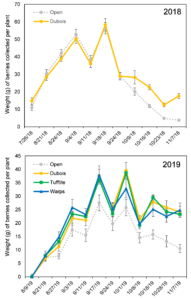
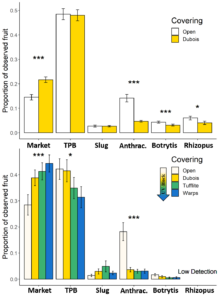

OBJECTIVE 2
Feeding assays comparing egg consumption by commercially-reared Neoseiulus fallacis and Phytoseiulus persimilis resulted in faster egg consumption by P. persimilis at 2 hrs. post inoculation, but higher consumption overall by N. fallacis (Fig. 7). Comparisons of no-predator controls, N. fallacis, P. persimilis, and a combination of both predator species on low tunnel strawberry in the field revealed a little difference between treatments (Fig. 4; p = 0.58 indicated by a generalized mixed-effects model), although the N. fallacis and combination treatments resulted in the lowest TSSM density. In addition, of predatory mites retrieved from the field, > 95% of them were N. fallacis. This suggests that this species may be the best option for long-term management of TSSM on low tunnel strawberries.
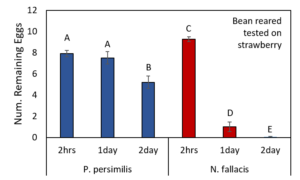
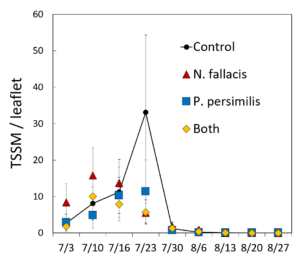
OBJECTIVE 3
Plastics had a significant effect on B. bassiana sporulation and pathogenicity against TPB when exposed to UV. Saran wrap and UV-transparent plastics resulted in the lowest proportion of germinated spores (Fig 8 and 9), and this also translated to increased longevity of inoculated insects (Fig 10). This suggests that UV-blocking plastics may be used to optimize B. bassiana efficacy and improve biocontrol of TPB, but experiments on strawberry in the field are needed.
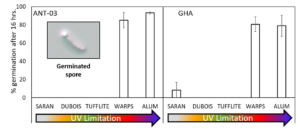

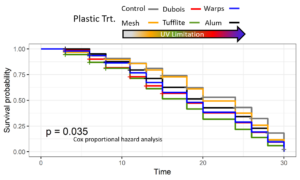
Our study demonstrated that growing strawberries under plastic low tunnels may result in higher yield and more marketable fruit. However, although tunnels reduced the presence of some pests (e.g., spotted wing drosophila and pathogens), they provided favorable conditions for others (e.g., ground-dwelling herbivores and spider mites). These results were largely consistent across plastic types (UV transmitting or UV blocking) indicating that tunnels provided a physical barrier against these pests, rather than a UV-barrier. Key pests of economic concern that were present at high densities under low tunnels included spider mites and tarnished plant bug. Biocontrol experiments in the lab suggested that commercially-reared Neoseiulus fallacis is likely to provide more effective control of spider mites than commercially-reared Phytoseiulus persimilis. In addition, very few P. persimilis individuals were recovered from the field after release. Although neither predators resulted in effective control in the field, these results combined that N. fallacis the best candidate for biocontrol on low tunnel strawberry. UV-blocking plastics reduced exposure of Beauveria bassiana to UV-B radiation, resulting in higher spore germination and infectivity of live tarnished plant bug. Overall, our study suggests that low tunnels provide an optimal environment for growing strawberries, and serve as a valuable tool to sustainably manage pests. Furthermore, strawberry growers using pathogens as biocontrol agents may benefit from using UV-blocking plastics in their low tunnel system.
Education & Outreach Activities and Participation Summary
Participation Summary:
Results of this reserach were used to produce three educational videos on low tunnel systems and spider mite monitoring: 1- https://www.youtube.com/watch?v=MC6wgKAyleo 2- https://www.youtube.com/watch?v=Pi2K68Ke3e8 3- https://www.youtube.com/watch?v=T0cNiISIeM8
This research was presented at the 2018 Great Lakes Fruit Workers Meeting in Ithaca, NY, the 2018 annual Entomological Society of America meeting in Vancouver, BC, the 2019 AgriTech annual symposium, the 2019 Entomological Society of America meeting in St. Louis, MO, and the 2020 Annual Cornell Entomology Symposium. This research was also a topic for an extension educator workshop organized by Esther Kibbe on berry pest management (see attachment for handout). This workshop took place in October 2019.
Project Outcomes
Results of this project will provide needed information on pest incidence and severity on protected culture strawberry, an important crop in NY and across the Northeast. This information contributes to sustainability by providing a foundation upon which management programs can be built. With this research, growers will be more aware of target pests on low tunnel strawberry. By targeting specific pests, growers can save resources and better protect their investment in low tunnel production systems. In addition, a major goal of this project was to provide recommendations for biological control of TSSM and TPB, which are devastating pests of protected culture strawberry. Alternative options for management of these pests are needed, especially as protected-culture systems become increasingly popular among growers in the Northeast. We hope recommendations provided by this research can be used by growers to create more efficient and sustainable strawberry production systems.
We have learned a great deal about sustainable production of strawberries in the Northeastern U.S. while conducting research for this project. We have specifically come to realize the great difficulty in conducting biological control experiments in the field with small pest targets, such as herbivorous mites. We hypothesize that the lack of success of predatory mites in controlling TSSM in the field was due to the high rate of predator dispersal from our strawberry plants, thus we will conduct further experiments to address this. In fact, we have established collaborations with commercial industry representatives and together submitted a NIFA Pre-Doctoral Fellowship in 2020 to evaluate predatory mite dispersal in more depth.
High predator retention is a crucial component of successful biological control. There are many factors influencing predator retention in the field, and for predatory mites, host plants appear to have a strong effect. Thus, we will conduct similar experiments as in 2018 but on several strawberry cultivars in the field during 2020. In addition, we will also test the effect of plastic type commonly used for low tunnels on TSSM population dynamics and predator retention.
Finally, we have become increasingly appreciative of the efforts growers and researchers make to better improve sustainable agricultural practices. After conducting pest surveys in the field to describe pest incidence on strawberry, we are now more aware of the immense pest pressure that occurs when pesticides are not used in a management program. Thus, we are even more motivated to solve this issue by further developing management practices that promote sustainability and responsible pest management.